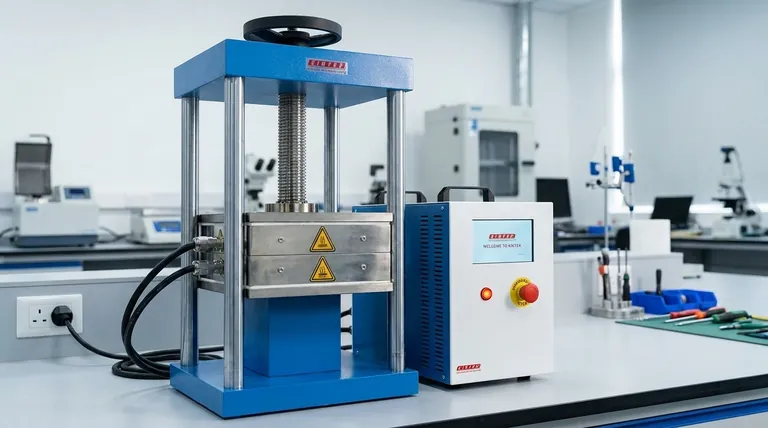In short, yes, most modern hydraulic presses use electricity. While the immense force is generated by pressurized fluid, that pressure is almost always created by a pump driven by a powerful electric motor. This makes electricity the essential energy source that initiates the entire hydraulic action for the vast majority of industrial and manufacturing applications.
The core principle to understand is one of energy conversion. A hydraulic press does not use electricity directly to press an object; instead, it uses electricity to power a motor, which drives a pump that pressurizes fluid, and it is this pressurized fluid that generates the force.

How Electricity Powers a Hydraulic System
A hydraulic press operates on a simple principle known as Pascal's Law: pressure applied to a confined fluid is transmitted undiminished throughout the fluid. However, creating that initial pressure requires a significant energy input, which is where electricity is used.
The Role of the Electric Motor
The electric motor is the prime mover of the system. It converts electrical energy into rotational mechanical energy.
For the demanding tasks found in metal fabrication and manufacturing—such as forging, punching, and forming—a consistent and powerful source of mechanical energy is non-negotiable. An electric motor provides this reliably and efficiently.
The Hydraulic Pump: From Motion to Pressure
The motor's rotating shaft is connected to a hydraulic pump. The pump's job is to draw hydraulic fluid (typically oil) from a reservoir and force it into the hydraulic cylinder.
This action doesn't create pressure on its own. It only creates a flow of fluid. Pressure builds when this flow meets resistance, which occurs when the fluid pushes against the piston in the press's main cylinder.
The Hydraulic Cylinder: Translating Pressure to Force
Once the high-pressure fluid enters the cylinder, it pushes against a large-surface-area piston. This is where force multiplication happens.
A small amount of force from the pump creates a high pressure, which, when applied over the large area of the piston, generates the massive tonnage a hydraulic press is known for. The entire sequence is initiated and sustained by the electric motor.
Understanding the Trade-offs
While electric-powered systems are the dominant standard for their power and efficiency, they are not the only option. Understanding the alternatives clarifies why electricity is so prevalent.
Why Electricity is the Standard
Power and Speed: Electric motors can run large pumps that move a high volume of fluid quickly, resulting in faster cycle times and the ability to generate extremely high tonnage. This is essential for industrial production.
Automation and Control: Electric systems are easily integrated with modern control systems (PLCs). This allows for precise, repeatable, and automated pressing cycles required in aerospace, automotive, and other high-tech industries.
Efficiency: For continuous or heavy-duty operation, electric motors provide a highly efficient conversion of energy into work compared to other methods.
Are There Non-Electric Alternatives?
Yes, primarily for smaller-scale or specialized applications.
Manual (Hand-Pump) Presses: These use a hand-operated lever to actuate a small piston pump. They are common in workshops for tasks like pressing bearings but are far too slow and low-force for industrial use.
Air-Over-Hydraulic (Pneumatic) Presses: These use compressed air to drive a hydraulic pump. They offer more force and speed than a manual press but are generally less powerful and less efficient than a fully electric-hydraulic system. They are often used when a shop already has a robust compressed air system available.
Making the Right Choice for Your Application
The power source is dictated by the scale and demands of the work.
- If your primary focus is industrial production, high tonnage, and speed: An electric-powered hydraulic press is the definitive choice for its unmatched power, efficiency, and control.
- If your primary focus is repair, maintenance, or small-scale fabrication without access to heavy-duty power: A manual hand-pump or an air-over-hydraulic press provides a practical and cost-effective solution.
Ultimately, understanding that electricity is the engine behind the hydraulic force empowers you to select the right tool for the job.
Summary Table:
| Power Source | Typical Use Case | Key Characteristics |
|---|---|---|
| Electric Motor | Industrial Manufacturing, High-Tonnage Applications | High power, fast cycle times, precise automation, high efficiency |
| Manual Hand-Pump | Workshops, Maintenance, Low-Force Tasks | Low cost, portable, no external power needed, slow operation |
| Air-Over-Hydraulic (Pneumatic) | Shops with Compressed Air, Medium-Force Applications | Moderate power and speed, relies on air compressor system |
Need a Reliable Hydraulic Press for Your Lab or Production Line?
Choosing the right power source is critical for efficiency and performance. At KINTEK, we specialize in lab equipment and consumables, offering a range of hydraulic presses tailored to your specific needs—whether for high-volume industrial manufacturing or precise laboratory tasks.
Let our experts help you select the perfect press to enhance your productivity and achieve consistent, high-quality results. Contact us today to discuss your application and get a personalized solution!
Visual Guide

Related Products
- Laboratory Hydraulic Press Split Electric Lab Pellet Press
- Automatic Laboratory Hydraulic Press for XRF & KBR Pellet Press
- Laboratory Hydraulic Press Lab Pellet Press Machine for Glove Box
- Laboratory Manual Hydraulic Pellet Press for Lab Use
- Manual Lab Heat Press
People Also Ask
- How much pressure can a hydraulic press make? From 1 Ton to 75,000+ Tons of Force
- What is KBr disc method? A Complete Guide to IR Spectroscopy Sample Prep
- How does pressure affect hydraulic system? Mastering Force, Efficiency, and Heat
- What is the purpose of KBr pellets? Unlock Clear FTIR Analysis of Solid Samples
- What is the use of potassium bromide in IR? Achieve Clear Solid Sample Analysis with KBr Pellets



















